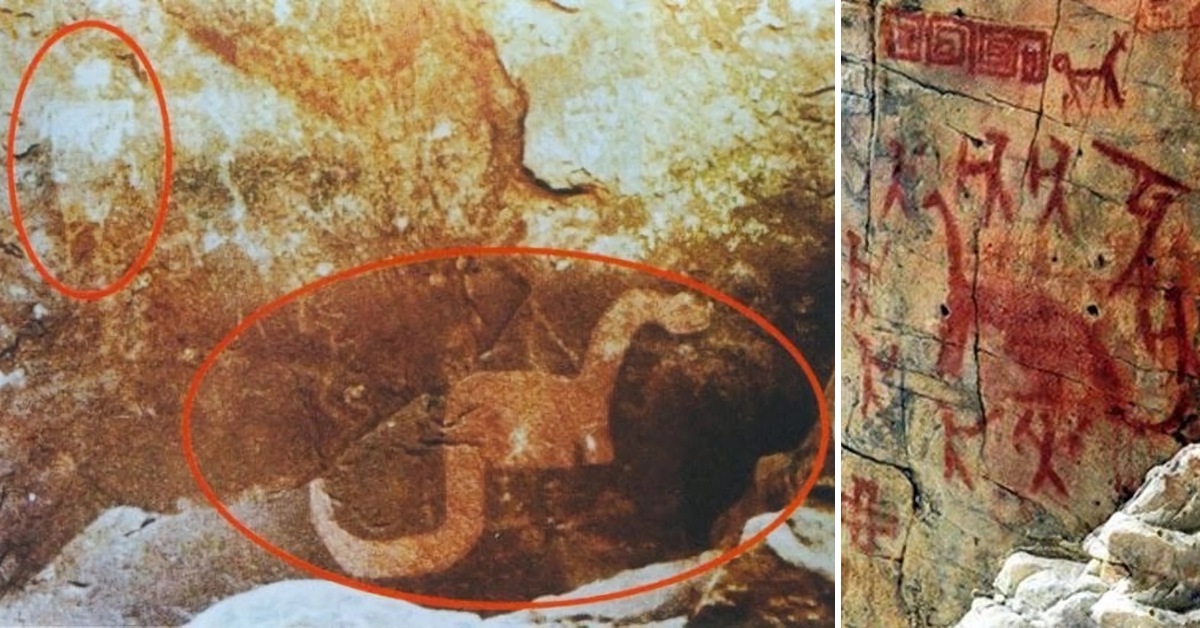Did our ancestors really see dinosaurs with their own eyes?

There is a long-standing debate among creationists and evolutionists about whether humans and dinosaurs ever lived together on Earth. Some creationists claim that there is evidence of human-dinosaur coexistence in ancient cave and rock paintings that depict dinosaur-like creatures. However, most scientists and scholars reject this claim and argue that these paintings are either misinterpreted, misdated, or hoaxes.
One of the most famous examples of alleged dinosaur cave art is the rock painting at Black Dragon Canyon in Utah, USA. Some creationists have argued that this painting depicts a winged monster or pterosaur, and is therefore proof that humans and dinosaurs once coexisted. However, a detailed analysis by archaeologists and paleontologists has shown that the painting is actually a composite of several images, including a snake, a human figure, and some geometric shapes. The apparent wings are actually cracks in the rock surface.

There are many other alleged “examples” of rock art depicting dinosaurs. According to Genesis Park, for example, in May 2012 researcher Vance Nelson brought their attention a collection of pictographs discovered on a rock ledge situated at the periphery of the Amazon rainforest basin near Yamon in the northern province of Utcabamba, Peru.
The website claims that “this artwork is said by secular archaeologists to be thousands of years old. Amazingly, one of the pictographs shows nine warriors hunting what appears to be a dinosaur.”

Genesis Park also claims, regarding another alleged dinosaur figure depicted below (thought to be created by the ancient Anasazi Native Americans, who inhabited what is now Utah from 150 B.C. to 1200 A.D.), that “even noted anti-creationists agree that it resembles a dinosaur and that the brownish film which has hardened over the picture, along with the pitting and weathering, attests to its age.”

While there is suspiciously little information about the alleged ancient Yamon dinosaur cave art, or even any cave art near Yamon per se, regarding the Utah petroglyph it can be said that scientists have had a thorough look at it. According to ICR, evolutionary biologist Phil Senter was initially impressed when he saw the drawing and told Discovery News, “We got there and I couldn’t believe it. It looked just like a sauropod.”
However, he later co-authored a paper in the online journal Paleontologica Electronica, stating that the sauropod-like image is not what it appears to be and that it is “a composite of two separate petroglyphs”, with the apparent “legs” created by a mud or mineral stain. So while the claim about the age and the weathering could indeed be right, the drawing hardly depicts a dinosaur.

Another example of purported dinosaur art is an animal relief, well, not on rock, but on the famous Ishtar Gate of Babylon, Iraq, that dates to the reign of Nebuchadnezzar II, 6th century BCE. Some creationists have suggested that one of the animals, called a mushkhushshu, is a representation of the dinosaur Iguanodon. However, historians and linguists have pointed out that the mushkhushshu was a mythical creature in Babylonian mythology, not a real animal. The mushkhushshu was also depicted differently in other Babylonian artworks, suggesting that it was not based on a consistent model.
There are many other examples of alleged dinosaur cave art around the world, but none of them have been convincingly verified by experts. Most of them are either ambiguous, inaccurate, or anachronistic. On the other hand, there is abundant evidence from fossils, geology, and genetics that humans and dinosaurs did not coexist. Dinosaurs went extinct about 65 million years ago, while the earliest humans appeared about 6 million years ago. There is no overlap between these two groups in the fossil record.

Therefore, based on the current scientific knowledge, it is highly unlikely that humans and dinosaurs ever lived together on Earth. The ancient drawings that some creationists claim to depict dinosaurs are either misinterpretations or fabrications. There is no credible evidence of human-dinosaur coexistence in ancient cave or rock art.
